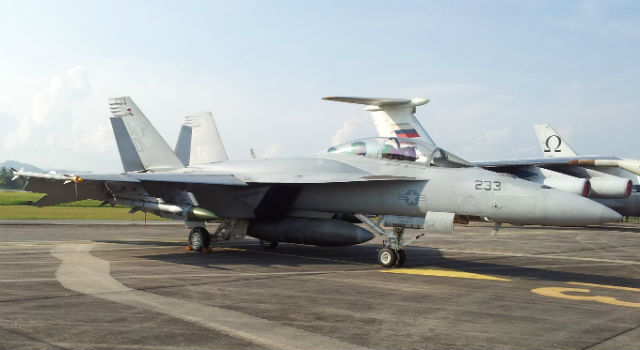Boeing and the US Navy have confirmed plans to demonstrate the use of conformal fuel tanks, a weapons pod and radar cross-section enhancements on the F/A-18E/F Super Hornet late this summer.
"We're actually doing a demo project this year, in concert with Boeing, to look at the conformal fuel tanks and the weapons pod there and some further signature enhancement efforts," says Capt Frank Morley, the Naval Air Systems Command (NAVAIR) programme manager for the F/A-18E/F and EA-18G. "That's not a navy programme of record but the demo is something that's supported by OPNAV [Office of the Chief of Naval Operations] and certainly by the programme."
 |
|---|
Greg Waldron/Flightglobal A Super Hornet was displayed with conformal fuel tank shapes at Malaysia's LIMA air show |
Although Boeing and Northrop Grumman are leading the project, the upgrades are applicable for future USN Super Hornet and EA-18G modernisation efforts, Morley says. The F/A-18E/F fleet is expected to be the mainstay of the naval air forces well into the 2030s.
The test programme for the Super Hornet upgrades will initially be conducted at Boeing's facilities in St Louis, Missouri, but will later move to NAS Patuxent River, Maryland, says Mike Gibbons, Boeing's vice-president for the F/A-18 and EA-18G programmes. Tests will be conducted on a USN-owned aircraft that will be leased back from the service by industry for the flight demonstrations, he says.
While Gibbons says that Boeing and Northrop Grumman are funding the demonstration project, he declines to say exactly how much money the industry team is investing in modernising the Super Hornet.
But industry is also investing in other improvements to the aircraft that are not going to be demonstrated during the flights tests later this year. The most significant of those developments are General Electric's enhanced F414 engines. In previous years, GE had touted versions of the F414 with either greater thrust or greater durability, but current developments are focused on combining both of these, Gibbons says.
"Significantly more thrust, which provides great acceleration improvements," Gibbons says. "In fact when accelerating from Mach 0.9 to Mach 1.4 - it takes, at various altitudes, a third of the time than it currently takes with that enhanced engine," he says. "Huge performance improvement."
But the same enhanced engine could be software modified to provide the same amount of power as the current F414 variants but with much greater durability and fuel economy.
Boeing's analysis shows that the USN could save $5 billion with the improved engines installed over the life of the Super Hornet fleet, Gibbons says.
If the USN were to adopt the enhanced engines, the new enhanced variant would fit into the existing F414 engines bays with no modifications needed. Gibbons adds that Boeing designed the Super Hornet's inlets to provide enough air for an uprated engine from the outset.
Source: Flight International























